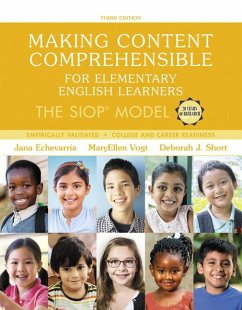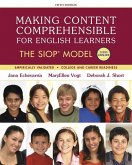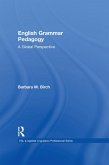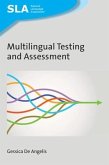Jana Echevarria, Maryellen Vogt, Deborah Short
Making Content Comprehensible for Elementary English Learners
The Siop Model
Jana Echevarria, Maryellen Vogt, Deborah Short
Making Content Comprehensible for Elementary English Learners
The Siop Model
- Broschiertes Buch
- Merkliste
- Auf die Merkliste
- Bewerten Bewerten
- Teilen
- Produkt teilen
- Produkterinnerung
- Produkterinnerung
For courses in ESL/EL Methods, and General Methods (Elementary) Note: This is the bound book only and does not include access to the Enhanced Pearson eText. To order the Enhanced Pearson eText packaged with a bound book, use ISBN 0134550129. A comprehensive, coherent, research-validated model designed for helping elementary English learners meet rigorous academic standards. In this comprehensive guide, elementary educators get a user-friendly approach for planning and implementing lessons that provide students access to grade-level content, develop students' academic English skills, and…mehr
Andere Kunden interessierten sich auch für
![Making Content Comprehensible for English Learners Making Content Comprehensible for English Learners]() Jana EchevarriaMaking Content Comprehensible for English Learners98,99 €
Jana EchevarriaMaking Content Comprehensible for English Learners98,99 €![Building Academic Language Through Content-Area Text: Strategies to Support English Language Learners [With CDROM] Building Academic Language Through Content-Area Text: Strategies to Support English Language Learners [With CDROM]]() Erica BowersBuilding Academic Language Through Content-Area Text: Strategies to Support English Language Learners [With CDROM]27,99 €
Erica BowersBuilding Academic Language Through Content-Area Text: Strategies to Support English Language Learners [With CDROM]27,99 €![Translingual Identities and Transnational Realities in the U.S. College Classroom Translingual Identities and Transnational Realities in the U.S. College Classroom]() Heather RobinsonTranslingual Identities and Transnational Realities in the U.S. College Classroom58,99 €
Heather RobinsonTranslingual Identities and Transnational Realities in the U.S. College Classroom58,99 €![English Grammar Pedagogy English Grammar Pedagogy]() Barbara M BirchEnglish Grammar Pedagogy43,99 €
Barbara M BirchEnglish Grammar Pedagogy43,99 €![Transnational Writing Education Transnational Writing Education]() Transnational Writing Education65,99 €
Transnational Writing Education65,99 €![English Language Teaching in South America English Language Teaching in South America]() English Language Teaching in South America60,99 €
English Language Teaching in South America60,99 €![Multilingual Testing and Assessment Multilingual Testing and Assessment]() Gessica De AngelisMultilingual Testing and Assessment42,99 €
Gessica De AngelisMultilingual Testing and Assessment42,99 €-
-
-
For courses in ESL/EL Methods, and General Methods (Elementary) Note: This is the bound book only and does not include access to the Enhanced Pearson eText. To order the Enhanced Pearson eText packaged with a bound book, use ISBN 0134550129. A comprehensive, coherent, research-validated model designed for helping elementary English learners meet rigorous academic standards. In this comprehensive guide, elementary educators get a user-friendly approach for planning and implementing lessons that provide students access to grade-level content, develop students' academic English skills, and prepare students to be college- and career-ready. Proven successful in improving teaching effectiveness and realizing academic gains for students, the SIOP Model presented in this book can be implemented in all content areas, and across grade levels and English proficiency levels. Highlights of the 3rd Edition include specific applications of SIOP to Common Core and other state standards, as well as new educational reforms such as ESSA. To help teachers implement the SIOP model, new learning aids have been added, including Reflect and Apply exercises, Teaching with Technology vignettes, a new SIOP lesson plan template and sample lesson plan, and a new user-friendly approach to identifying and writing language objectives. The Enhanced Pearson eText version provides embedded video links that enable students to see the SIOP model in action, along with interviews featuring SIOP educators. Invigorate learning with the Enhanced Pearson eText The Enhanced Pearson eText provides a rich, interactive learning environment designed to improve student mastery of content with embedded videos and Check Your Understanding quizzes. The Enhanced Pearson eText is also available without a print version of the textbook. Instructors, visit pearsonhighered.com/etextbooks/ted to register for your digital examination copy. Students, register for or purchase your eText at pearsonhighered.com/etextbooks/ted.
Hinweis: Dieser Artikel kann nur an eine deutsche Lieferadresse ausgeliefert werden.
Hinweis: Dieser Artikel kann nur an eine deutsche Lieferadresse ausgeliefert werden.
Produktdetails
- Produktdetails
- Verlag: Pearson Education
- 3rd edition
- Seitenzahl: 384
- Erscheinungstermin: 9. Januar 2017
- Englisch
- Abmessung: 272mm x 213mm x 15mm
- Gewicht: 658g
- ISBN-13: 9780134550206
- ISBN-10: 013455020X
- Artikelnr.: 47446898
- Herstellerkennzeichnung
- Libri GmbH
- Europaallee 1
- 36244 Bad Hersfeld
- 06621 890
- Verlag: Pearson Education
- 3rd edition
- Seitenzahl: 384
- Erscheinungstermin: 9. Januar 2017
- Englisch
- Abmessung: 272mm x 213mm x 15mm
- Gewicht: 658g
- ISBN-13: 9780134550206
- ISBN-10: 013455020X
- Artikelnr.: 47446898
- Herstellerkennzeichnung
- Libri GmbH
- Europaallee 1
- 36244 Bad Hersfeld
- 06621 890
Jana Echevarría, PhD, is Professor Emerita at California State University, Long Beach where she was selected as Outstanding Professor. She has taught in general education, special education, ESL, and bilingual programs in U.S. schools, and has lived and worked in Taiwan, Mexico, Spain, and in Macedonia where she was a Fulbright Specialist. Her research and publications focus on effective instruction for English learners, including those with learning disabilities. She has presented her research across the United States and internationally including Oxford University (England), Wits University (South Africa), Harvard University (United States), Stanford University (United States), University of Barcelona (Spain) and South East Europe University (Macedonia). A founding researcher of the SIOP Model, her publications include more than 60 books, book chapters and journal articles. Currently she serves as the EL expert for the U.S. Department of Justice on the Lau case. Her blog is found at www.janaechevarria.com. MaryEllen Vogt, EdD, is Professor Emerita of Education at California State University, Long Beach. Dr. Vogt, a former classroom teacher, reading specialist, curriculum coordinator, and teacher educator, received her doctorate from the University of California, Berkeley. She is an author of numerous articles and chapters, and is co-author of seventeen books for teachers and administrators, including Professional Learning in Action: An Inquiry Approach for Teachers of Learning (Risko & Vogt, 2016). Her research interests include improving comprehension in the content areas, teacher change and development, and content literacy and language acquisition for English learners. Dr. Vogt has provided professional development in all fifty states and in several countries, including Germany, where she served as a Visiting Scholar at the University of Cologne. She was inducted into the California Reading Hall of Fame, received her university’s Distinguished Faculty Teaching Award, and served as President of the International Reading Association. Deborah J. Short, PhD, founded and directs Academic Language Research & Training, a consulting company, and provides professional development on sheltered instruction, content-based language teaching, and academic literacy worldwide. Formerly she was a Division Director at the Center for Applied Linguistics, Washington, DC, where she co-developed the SIOP Model and directed quasi-experimental and experimental studies on English learners funded by the Carnegie Corporation of New York, Rockefeller Foundation, and U.S. Department of Education, among others. Her publications include journal articles, the SIOP® Model book series, and several ESL textbook series for National Geographic/Cengage. She taught English as a second/foreign language in New York, California, Virginia, and the Democratic Republic of the Congo. She has served on the Board of Directors of the TESOL International Association and has presented research in the United States, Canada, New Zealand, Brazil, Colombia, Europe, and the Middle East.
Brief Table of Contents 1. Introducing the SIOP® Model 2. Lesson
Preparation
3. Building Background
4. Comprehensible Input
5. Strategies
6. Interaction
7. Practice & Application
8. Lesson Delivery
9. Review & Assessment
10. Issues of Reading, RTI, and Special Education for English Learners
11. Effective Use of the SIOP® Protocol
12. Frequently Asked Questions: Getting Started with the SIOP® Model
Appendix A: SIOP (Sheltered Instruction Observation Protocol) Appendix B:
Lesson Plans Appendix C: Research on the SIOP (Sheltered Instruction
Observation Protocol) Model Appendix D: SIOP Professional Development
Resources Glossary References Index Detailed Table of Contents
1. Introducing the SIOP® Model
Background on English Learners
Demographic Trends
Diverse Characteristics
School Reform, Standards, and Accountability
Achievement Gaps
Academic Language and Literacy
Research on Academic Language and Literacy
Role in Schooling
Effective Instructional Practice for English Learners: The SIOP® Model
Content-based ESL and Sheltered Content Instruction
Research and Development of the Sheltered Instruction Observation Protocol
(SIOP®) Model
Effective SIOP® Model Instruction
Implementing the SIOP® Model
Summary
Discussion Questions
2. Lesson Preparation
Background
SIOP® Feature 1: Content Objectives Clearly Defined, Displayed, and
Reviewed with Students
SIOP® Feature 2: Language Objectives Clearly Defined, Displayed, and
Reviewed with Students
Selecting and Writing Content and Language Objectives
SIOP® Feature 3: Content Concepts Appropriate for Age and Educational
Background Level of Students
SIOP® Feature 4: Supplementary Materials Used to a High Degree, Making the
Lesson Clear and Meaningful
SIOP® Feature 5: Adaptation of Content to All Levels of Student Proficiency
SIOP® Feature 6: Meaningful Activities That Integrate Lesson Concepts with
Language Practice Opportunities for Reading, Writing, Listening, and/or
Speaking
Teaching Ideas for Lesson Preparation
Differentiating Ideas for Multi-level Classes
Rating Lessons with the SIOP® Protocol
The Lesson
Teaching Scenarios
Discussion of Lessons
Teaching with Technology
Summary
Discussion Questions
3. Building Background
Background
SIOP® Feature 7: Concepts Explicitly Linked to Students’ Background
Experiences
Something to Think About
SIOP® Feature 8: Links Explicitly Made between Past Learning and New
Concepts
SIOP® Feature 9: Key Vocabulary Emphasized
Academic Vocabulary
Word Consciousness
Teaching Academic Vocabulary
Teaching Ideas for Building Background
Differentiating Ideas for Multi-level Classes
The Lesson
Teaching Scenarios
Discussion of Lessons
Teaching with Technology
Summary
Discussion Questions
4. Comprehensible Input
Background
SIOP® Feature 10: Speech Appropriate for Students’ Proficiency Levels
SIOP® Feature 11: Clear Explanation of Academic Tasks
SIOP® Feature 12: A Variety of Techniques Used to Make Content Concepts
Clear
Teaching Ideas for Comprehensible Input
Differentiating Ideas for Multi-level Classes
The Lesson
Teaching Scenarios
Discussion of Lessons
Teaching with Technology
Summary
Discussion Questions
5. Strategies
Background
SIOP® Feature 13: Ample Opportunities Provided for Students to Use Learning
Strategies
Things to Consider When Teaching Learning Strategies
SIOP® Feature 14: Scaffolding Techniques Consistently Used, Assisting and
Supporting Student Understanding
Three Types of Scaffolding
SIOP® Feature 15: A Variety of Questions or Tasks That Promote Higher-Order
Thinking Skills
Teaching Ideas for Strategies
Differentiating Ideas for Multi-level Classes
The Lesson
Teaching Scenarios
Discussion of Lessons
Teaching with Technology
Summary
Discussion Questions
6. Interaction
Background
Typical Lesson
SIOP® Lesson
SIOP® Feature 16: Frequent Opportunities for Interaction and Discussion
Between Teacher/Student and Among Students, Which Encourage Elaborated
Responses About Lesson Concepts
Oral Language Development
SIOP® Feature 17: Grouping Configurations Support Language and Content
Objectives of the Lesson
SIOP® Feature 18: Sufficient Wait Time for Student Responses Consistently
Provided
SIOP® Feature 19: Ample Opportunity for Students to Clarify Key Concepts in
L1 as Needed with Aide, Peer, or L1 Text
Teaching Ideas for Interaction
Differentiating Ideas for Multi-level Classes
The Lesson
Teaching Scenarios
Discussion of Lessons
Teaching with Technology
Summary
Discussion Questions
7. Practice & Application
Background
SIOP® Feature 20: Hands-On Materials and/or Manipulatives Provided for
Students to Practice Using New Content Knowledge in the Classroom
SIOP® Feature 21: Activities Provided for Students to Apply Content and
Language Knowledge
SIOP® Feature 22: Activities Integrate All Language Skills
Teaching Ideas for Practice & Application
Differentiating Ideas for Multi-level Classes
The Lesson
Teaching Scenarios
Discussion of Lessons
Teaching with Technology
Summary
Discussion Questions
8. Lesson Delivery
Background
SIOP® Feature 23: Content Objectives Clearly Supported by Lesson Delivery
SIOP® Feature 24: Language Objectives Clearly Supported by Lesson Delivery
SIOP® Feature 25: Students Engaged Approximately 90% to 100% of the Period
SIOP® Feature 26: Pacing of the Lesson Appropriate to Students’ Ability
Levels
Linking Lesson Preparation and Lesson Delivery
Teaching Ideas for Lesson Delivery
Differentiating Ideas for Multi-level Classes
The Lesson
Teaching Scenarios
Discussion of Lessons
Teaching with Technology
Summary
Discussion Questions
9. Review & Assessment
Background
Classroom Context and the Review & Assessment Component
Formative and Summative Assessment
Informal Assessment
Formal Assessment
SIOP® Feature 27: Comprehensive Review of Key Vocabulary
SIOP® Feature 28: Comprehensive Review of Key Content Concepts
SIOP® Feature 29: Regular Feedback Provided to Students on Their Output
SIOP® Feature 30: Assessment of Student Comprehension and Learning of All
Lesson Objectives Throughout the Lesson
Teaching Ideas for Review & Assessment
Differentiating Ideas for Multi-level Classes
The Lesson
Teaching Scenarios
Discussion of Lessons
Teaching with Technology
Summary
Discussion Questions
10. Issues of Reading, RTI, and Special Education for English Learners
Issues of Reading Development and Assessment
Estimating Students’ Reading Levels
English Learners and the Common Core State Standards for Reading, Writing,
Listening, and Speaking
Assisting Struggling Learners: Response to Intervention
Issues Related to Special Education
Special Education Services: When Are They Appropriate?
Search for Intervention Rather than Disability
Teaching Ideas for Students with Special Needs
Summary
Discussion Questions
11. Effective Use of the SIOP® Protocol
Best Practice in Using the SIOP® Protocol
Scoring and Interpreting the SIOP® Protocol
Assigning Scores
Not Applicable (NA) Category
Calculating Scores
Using Non-Numeric Rating
Sample Lesson
Using SIOP® Scores and Comments
Reliability and Validity of the SIOP®
Summary
Discussion Questions
12. Frequently Asked Questions: Getting Started with the SIOP® Model
General SIOP® Questions
Questions About Getting Started with SIOP® in the Classroom
Questions About School-wide Implementation of the SIOP® Model
Appendix A: SIOP (Sheltered Instruction Observation Protocol)
Appendix B: Lesson Plans
Appendix C: Research on the SIOP (Sheltered Instruction Observation
Protocol) Model
Appendix D: SIOP Professional Development Resources
Glossary
References
Index
Preparation
3. Building Background
4. Comprehensible Input
5. Strategies
6. Interaction
7. Practice & Application
8. Lesson Delivery
9. Review & Assessment
10. Issues of Reading, RTI, and Special Education for English Learners
11. Effective Use of the SIOP® Protocol
12. Frequently Asked Questions: Getting Started with the SIOP® Model
Appendix A: SIOP (Sheltered Instruction Observation Protocol) Appendix B:
Lesson Plans Appendix C: Research on the SIOP (Sheltered Instruction
Observation Protocol) Model Appendix D: SIOP Professional Development
Resources Glossary References Index Detailed Table of Contents
1. Introducing the SIOP® Model
Background on English Learners
Demographic Trends
Diverse Characteristics
School Reform, Standards, and Accountability
Achievement Gaps
Academic Language and Literacy
Research on Academic Language and Literacy
Role in Schooling
Effective Instructional Practice for English Learners: The SIOP® Model
Content-based ESL and Sheltered Content Instruction
Research and Development of the Sheltered Instruction Observation Protocol
(SIOP®) Model
Effective SIOP® Model Instruction
Implementing the SIOP® Model
Summary
Discussion Questions
2. Lesson Preparation
Background
SIOP® Feature 1: Content Objectives Clearly Defined, Displayed, and
Reviewed with Students
SIOP® Feature 2: Language Objectives Clearly Defined, Displayed, and
Reviewed with Students
Selecting and Writing Content and Language Objectives
SIOP® Feature 3: Content Concepts Appropriate for Age and Educational
Background Level of Students
SIOP® Feature 4: Supplementary Materials Used to a High Degree, Making the
Lesson Clear and Meaningful
SIOP® Feature 5: Adaptation of Content to All Levels of Student Proficiency
SIOP® Feature 6: Meaningful Activities That Integrate Lesson Concepts with
Language Practice Opportunities for Reading, Writing, Listening, and/or
Speaking
Teaching Ideas for Lesson Preparation
Differentiating Ideas for Multi-level Classes
Rating Lessons with the SIOP® Protocol
The Lesson
Teaching Scenarios
Discussion of Lessons
Teaching with Technology
Summary
Discussion Questions
3. Building Background
Background
SIOP® Feature 7: Concepts Explicitly Linked to Students’ Background
Experiences
Something to Think About
SIOP® Feature 8: Links Explicitly Made between Past Learning and New
Concepts
SIOP® Feature 9: Key Vocabulary Emphasized
Academic Vocabulary
Word Consciousness
Teaching Academic Vocabulary
Teaching Ideas for Building Background
Differentiating Ideas for Multi-level Classes
The Lesson
Teaching Scenarios
Discussion of Lessons
Teaching with Technology
Summary
Discussion Questions
4. Comprehensible Input
Background
SIOP® Feature 10: Speech Appropriate for Students’ Proficiency Levels
SIOP® Feature 11: Clear Explanation of Academic Tasks
SIOP® Feature 12: A Variety of Techniques Used to Make Content Concepts
Clear
Teaching Ideas for Comprehensible Input
Differentiating Ideas for Multi-level Classes
The Lesson
Teaching Scenarios
Discussion of Lessons
Teaching with Technology
Summary
Discussion Questions
5. Strategies
Background
SIOP® Feature 13: Ample Opportunities Provided for Students to Use Learning
Strategies
Things to Consider When Teaching Learning Strategies
SIOP® Feature 14: Scaffolding Techniques Consistently Used, Assisting and
Supporting Student Understanding
Three Types of Scaffolding
SIOP® Feature 15: A Variety of Questions or Tasks That Promote Higher-Order
Thinking Skills
Teaching Ideas for Strategies
Differentiating Ideas for Multi-level Classes
The Lesson
Teaching Scenarios
Discussion of Lessons
Teaching with Technology
Summary
Discussion Questions
6. Interaction
Background
Typical Lesson
SIOP® Lesson
SIOP® Feature 16: Frequent Opportunities for Interaction and Discussion
Between Teacher/Student and Among Students, Which Encourage Elaborated
Responses About Lesson Concepts
Oral Language Development
SIOP® Feature 17: Grouping Configurations Support Language and Content
Objectives of the Lesson
SIOP® Feature 18: Sufficient Wait Time for Student Responses Consistently
Provided
SIOP® Feature 19: Ample Opportunity for Students to Clarify Key Concepts in
L1 as Needed with Aide, Peer, or L1 Text
Teaching Ideas for Interaction
Differentiating Ideas for Multi-level Classes
The Lesson
Teaching Scenarios
Discussion of Lessons
Teaching with Technology
Summary
Discussion Questions
7. Practice & Application
Background
SIOP® Feature 20: Hands-On Materials and/or Manipulatives Provided for
Students to Practice Using New Content Knowledge in the Classroom
SIOP® Feature 21: Activities Provided for Students to Apply Content and
Language Knowledge
SIOP® Feature 22: Activities Integrate All Language Skills
Teaching Ideas for Practice & Application
Differentiating Ideas for Multi-level Classes
The Lesson
Teaching Scenarios
Discussion of Lessons
Teaching with Technology
Summary
Discussion Questions
8. Lesson Delivery
Background
SIOP® Feature 23: Content Objectives Clearly Supported by Lesson Delivery
SIOP® Feature 24: Language Objectives Clearly Supported by Lesson Delivery
SIOP® Feature 25: Students Engaged Approximately 90% to 100% of the Period
SIOP® Feature 26: Pacing of the Lesson Appropriate to Students’ Ability
Levels
Linking Lesson Preparation and Lesson Delivery
Teaching Ideas for Lesson Delivery
Differentiating Ideas for Multi-level Classes
The Lesson
Teaching Scenarios
Discussion of Lessons
Teaching with Technology
Summary
Discussion Questions
9. Review & Assessment
Background
Classroom Context and the Review & Assessment Component
Formative and Summative Assessment
Informal Assessment
Formal Assessment
SIOP® Feature 27: Comprehensive Review of Key Vocabulary
SIOP® Feature 28: Comprehensive Review of Key Content Concepts
SIOP® Feature 29: Regular Feedback Provided to Students on Their Output
SIOP® Feature 30: Assessment of Student Comprehension and Learning of All
Lesson Objectives Throughout the Lesson
Teaching Ideas for Review & Assessment
Differentiating Ideas for Multi-level Classes
The Lesson
Teaching Scenarios
Discussion of Lessons
Teaching with Technology
Summary
Discussion Questions
10. Issues of Reading, RTI, and Special Education for English Learners
Issues of Reading Development and Assessment
Estimating Students’ Reading Levels
English Learners and the Common Core State Standards for Reading, Writing,
Listening, and Speaking
Assisting Struggling Learners: Response to Intervention
Issues Related to Special Education
Special Education Services: When Are They Appropriate?
Search for Intervention Rather than Disability
Teaching Ideas for Students with Special Needs
Summary
Discussion Questions
11. Effective Use of the SIOP® Protocol
Best Practice in Using the SIOP® Protocol
Scoring and Interpreting the SIOP® Protocol
Assigning Scores
Not Applicable (NA) Category
Calculating Scores
Using Non-Numeric Rating
Sample Lesson
Using SIOP® Scores and Comments
Reliability and Validity of the SIOP®
Summary
Discussion Questions
12. Frequently Asked Questions: Getting Started with the SIOP® Model
General SIOP® Questions
Questions About Getting Started with SIOP® in the Classroom
Questions About School-wide Implementation of the SIOP® Model
Appendix A: SIOP (Sheltered Instruction Observation Protocol)
Appendix B: Lesson Plans
Appendix C: Research on the SIOP (Sheltered Instruction Observation
Protocol) Model
Appendix D: SIOP Professional Development Resources
Glossary
References
Index
Brief Table of Contents 1. Introducing the SIOP® Model 2. Lesson
Preparation
3. Building Background
4. Comprehensible Input
5. Strategies
6. Interaction
7. Practice & Application
8. Lesson Delivery
9. Review & Assessment
10. Issues of Reading, RTI, and Special Education for English Learners
11. Effective Use of the SIOP® Protocol
12. Frequently Asked Questions: Getting Started with the SIOP® Model
Appendix A: SIOP (Sheltered Instruction Observation Protocol) Appendix B:
Lesson Plans Appendix C: Research on the SIOP (Sheltered Instruction
Observation Protocol) Model Appendix D: SIOP Professional Development
Resources Glossary References Index Detailed Table of Contents
1. Introducing the SIOP® Model
Background on English Learners
Demographic Trends
Diverse Characteristics
School Reform, Standards, and Accountability
Achievement Gaps
Academic Language and Literacy
Research on Academic Language and Literacy
Role in Schooling
Effective Instructional Practice for English Learners: The SIOP® Model
Content-based ESL and Sheltered Content Instruction
Research and Development of the Sheltered Instruction Observation Protocol
(SIOP®) Model
Effective SIOP® Model Instruction
Implementing the SIOP® Model
Summary
Discussion Questions
2. Lesson Preparation
Background
SIOP® Feature 1: Content Objectives Clearly Defined, Displayed, and
Reviewed with Students
SIOP® Feature 2: Language Objectives Clearly Defined, Displayed, and
Reviewed with Students
Selecting and Writing Content and Language Objectives
SIOP® Feature 3: Content Concepts Appropriate for Age and Educational
Background Level of Students
SIOP® Feature 4: Supplementary Materials Used to a High Degree, Making the
Lesson Clear and Meaningful
SIOP® Feature 5: Adaptation of Content to All Levels of Student Proficiency
SIOP® Feature 6: Meaningful Activities That Integrate Lesson Concepts with
Language Practice Opportunities for Reading, Writing, Listening, and/or
Speaking
Teaching Ideas for Lesson Preparation
Differentiating Ideas for Multi-level Classes
Rating Lessons with the SIOP® Protocol
The Lesson
Teaching Scenarios
Discussion of Lessons
Teaching with Technology
Summary
Discussion Questions
3. Building Background
Background
SIOP® Feature 7: Concepts Explicitly Linked to Students’ Background
Experiences
Something to Think About
SIOP® Feature 8: Links Explicitly Made between Past Learning and New
Concepts
SIOP® Feature 9: Key Vocabulary Emphasized
Academic Vocabulary
Word Consciousness
Teaching Academic Vocabulary
Teaching Ideas for Building Background
Differentiating Ideas for Multi-level Classes
The Lesson
Teaching Scenarios
Discussion of Lessons
Teaching with Technology
Summary
Discussion Questions
4. Comprehensible Input
Background
SIOP® Feature 10: Speech Appropriate for Students’ Proficiency Levels
SIOP® Feature 11: Clear Explanation of Academic Tasks
SIOP® Feature 12: A Variety of Techniques Used to Make Content Concepts
Clear
Teaching Ideas for Comprehensible Input
Differentiating Ideas for Multi-level Classes
The Lesson
Teaching Scenarios
Discussion of Lessons
Teaching with Technology
Summary
Discussion Questions
5. Strategies
Background
SIOP® Feature 13: Ample Opportunities Provided for Students to Use Learning
Strategies
Things to Consider When Teaching Learning Strategies
SIOP® Feature 14: Scaffolding Techniques Consistently Used, Assisting and
Supporting Student Understanding
Three Types of Scaffolding
SIOP® Feature 15: A Variety of Questions or Tasks That Promote Higher-Order
Thinking Skills
Teaching Ideas for Strategies
Differentiating Ideas for Multi-level Classes
The Lesson
Teaching Scenarios
Discussion of Lessons
Teaching with Technology
Summary
Discussion Questions
6. Interaction
Background
Typical Lesson
SIOP® Lesson
SIOP® Feature 16: Frequent Opportunities for Interaction and Discussion
Between Teacher/Student and Among Students, Which Encourage Elaborated
Responses About Lesson Concepts
Oral Language Development
SIOP® Feature 17: Grouping Configurations Support Language and Content
Objectives of the Lesson
SIOP® Feature 18: Sufficient Wait Time for Student Responses Consistently
Provided
SIOP® Feature 19: Ample Opportunity for Students to Clarify Key Concepts in
L1 as Needed with Aide, Peer, or L1 Text
Teaching Ideas for Interaction
Differentiating Ideas for Multi-level Classes
The Lesson
Teaching Scenarios
Discussion of Lessons
Teaching with Technology
Summary
Discussion Questions
7. Practice & Application
Background
SIOP® Feature 20: Hands-On Materials and/or Manipulatives Provided for
Students to Practice Using New Content Knowledge in the Classroom
SIOP® Feature 21: Activities Provided for Students to Apply Content and
Language Knowledge
SIOP® Feature 22: Activities Integrate All Language Skills
Teaching Ideas for Practice & Application
Differentiating Ideas for Multi-level Classes
The Lesson
Teaching Scenarios
Discussion of Lessons
Teaching with Technology
Summary
Discussion Questions
8. Lesson Delivery
Background
SIOP® Feature 23: Content Objectives Clearly Supported by Lesson Delivery
SIOP® Feature 24: Language Objectives Clearly Supported by Lesson Delivery
SIOP® Feature 25: Students Engaged Approximately 90% to 100% of the Period
SIOP® Feature 26: Pacing of the Lesson Appropriate to Students’ Ability
Levels
Linking Lesson Preparation and Lesson Delivery
Teaching Ideas for Lesson Delivery
Differentiating Ideas for Multi-level Classes
The Lesson
Teaching Scenarios
Discussion of Lessons
Teaching with Technology
Summary
Discussion Questions
9. Review & Assessment
Background
Classroom Context and the Review & Assessment Component
Formative and Summative Assessment
Informal Assessment
Formal Assessment
SIOP® Feature 27: Comprehensive Review of Key Vocabulary
SIOP® Feature 28: Comprehensive Review of Key Content Concepts
SIOP® Feature 29: Regular Feedback Provided to Students on Their Output
SIOP® Feature 30: Assessment of Student Comprehension and Learning of All
Lesson Objectives Throughout the Lesson
Teaching Ideas for Review & Assessment
Differentiating Ideas for Multi-level Classes
The Lesson
Teaching Scenarios
Discussion of Lessons
Teaching with Technology
Summary
Discussion Questions
10. Issues of Reading, RTI, and Special Education for English Learners
Issues of Reading Development and Assessment
Estimating Students’ Reading Levels
English Learners and the Common Core State Standards for Reading, Writing,
Listening, and Speaking
Assisting Struggling Learners: Response to Intervention
Issues Related to Special Education
Special Education Services: When Are They Appropriate?
Search for Intervention Rather than Disability
Teaching Ideas for Students with Special Needs
Summary
Discussion Questions
11. Effective Use of the SIOP® Protocol
Best Practice in Using the SIOP® Protocol
Scoring and Interpreting the SIOP® Protocol
Assigning Scores
Not Applicable (NA) Category
Calculating Scores
Using Non-Numeric Rating
Sample Lesson
Using SIOP® Scores and Comments
Reliability and Validity of the SIOP®
Summary
Discussion Questions
12. Frequently Asked Questions: Getting Started with the SIOP® Model
General SIOP® Questions
Questions About Getting Started with SIOP® in the Classroom
Questions About School-wide Implementation of the SIOP® Model
Appendix A: SIOP (Sheltered Instruction Observation Protocol)
Appendix B: Lesson Plans
Appendix C: Research on the SIOP (Sheltered Instruction Observation
Protocol) Model
Appendix D: SIOP Professional Development Resources
Glossary
References
Index
Preparation
3. Building Background
4. Comprehensible Input
5. Strategies
6. Interaction
7. Practice & Application
8. Lesson Delivery
9. Review & Assessment
10. Issues of Reading, RTI, and Special Education for English Learners
11. Effective Use of the SIOP® Protocol
12. Frequently Asked Questions: Getting Started with the SIOP® Model
Appendix A: SIOP (Sheltered Instruction Observation Protocol) Appendix B:
Lesson Plans Appendix C: Research on the SIOP (Sheltered Instruction
Observation Protocol) Model Appendix D: SIOP Professional Development
Resources Glossary References Index Detailed Table of Contents
1. Introducing the SIOP® Model
Background on English Learners
Demographic Trends
Diverse Characteristics
School Reform, Standards, and Accountability
Achievement Gaps
Academic Language and Literacy
Research on Academic Language and Literacy
Role in Schooling
Effective Instructional Practice for English Learners: The SIOP® Model
Content-based ESL and Sheltered Content Instruction
Research and Development of the Sheltered Instruction Observation Protocol
(SIOP®) Model
Effective SIOP® Model Instruction
Implementing the SIOP® Model
Summary
Discussion Questions
2. Lesson Preparation
Background
SIOP® Feature 1: Content Objectives Clearly Defined, Displayed, and
Reviewed with Students
SIOP® Feature 2: Language Objectives Clearly Defined, Displayed, and
Reviewed with Students
Selecting and Writing Content and Language Objectives
SIOP® Feature 3: Content Concepts Appropriate for Age and Educational
Background Level of Students
SIOP® Feature 4: Supplementary Materials Used to a High Degree, Making the
Lesson Clear and Meaningful
SIOP® Feature 5: Adaptation of Content to All Levels of Student Proficiency
SIOP® Feature 6: Meaningful Activities That Integrate Lesson Concepts with
Language Practice Opportunities for Reading, Writing, Listening, and/or
Speaking
Teaching Ideas for Lesson Preparation
Differentiating Ideas for Multi-level Classes
Rating Lessons with the SIOP® Protocol
The Lesson
Teaching Scenarios
Discussion of Lessons
Teaching with Technology
Summary
Discussion Questions
3. Building Background
Background
SIOP® Feature 7: Concepts Explicitly Linked to Students’ Background
Experiences
Something to Think About
SIOP® Feature 8: Links Explicitly Made between Past Learning and New
Concepts
SIOP® Feature 9: Key Vocabulary Emphasized
Academic Vocabulary
Word Consciousness
Teaching Academic Vocabulary
Teaching Ideas for Building Background
Differentiating Ideas for Multi-level Classes
The Lesson
Teaching Scenarios
Discussion of Lessons
Teaching with Technology
Summary
Discussion Questions
4. Comprehensible Input
Background
SIOP® Feature 10: Speech Appropriate for Students’ Proficiency Levels
SIOP® Feature 11: Clear Explanation of Academic Tasks
SIOP® Feature 12: A Variety of Techniques Used to Make Content Concepts
Clear
Teaching Ideas for Comprehensible Input
Differentiating Ideas for Multi-level Classes
The Lesson
Teaching Scenarios
Discussion of Lessons
Teaching with Technology
Summary
Discussion Questions
5. Strategies
Background
SIOP® Feature 13: Ample Opportunities Provided for Students to Use Learning
Strategies
Things to Consider When Teaching Learning Strategies
SIOP® Feature 14: Scaffolding Techniques Consistently Used, Assisting and
Supporting Student Understanding
Three Types of Scaffolding
SIOP® Feature 15: A Variety of Questions or Tasks That Promote Higher-Order
Thinking Skills
Teaching Ideas for Strategies
Differentiating Ideas for Multi-level Classes
The Lesson
Teaching Scenarios
Discussion of Lessons
Teaching with Technology
Summary
Discussion Questions
6. Interaction
Background
Typical Lesson
SIOP® Lesson
SIOP® Feature 16: Frequent Opportunities for Interaction and Discussion
Between Teacher/Student and Among Students, Which Encourage Elaborated
Responses About Lesson Concepts
Oral Language Development
SIOP® Feature 17: Grouping Configurations Support Language and Content
Objectives of the Lesson
SIOP® Feature 18: Sufficient Wait Time for Student Responses Consistently
Provided
SIOP® Feature 19: Ample Opportunity for Students to Clarify Key Concepts in
L1 as Needed with Aide, Peer, or L1 Text
Teaching Ideas for Interaction
Differentiating Ideas for Multi-level Classes
The Lesson
Teaching Scenarios
Discussion of Lessons
Teaching with Technology
Summary
Discussion Questions
7. Practice & Application
Background
SIOP® Feature 20: Hands-On Materials and/or Manipulatives Provided for
Students to Practice Using New Content Knowledge in the Classroom
SIOP® Feature 21: Activities Provided for Students to Apply Content and
Language Knowledge
SIOP® Feature 22: Activities Integrate All Language Skills
Teaching Ideas for Practice & Application
Differentiating Ideas for Multi-level Classes
The Lesson
Teaching Scenarios
Discussion of Lessons
Teaching with Technology
Summary
Discussion Questions
8. Lesson Delivery
Background
SIOP® Feature 23: Content Objectives Clearly Supported by Lesson Delivery
SIOP® Feature 24: Language Objectives Clearly Supported by Lesson Delivery
SIOP® Feature 25: Students Engaged Approximately 90% to 100% of the Period
SIOP® Feature 26: Pacing of the Lesson Appropriate to Students’ Ability
Levels
Linking Lesson Preparation and Lesson Delivery
Teaching Ideas for Lesson Delivery
Differentiating Ideas for Multi-level Classes
The Lesson
Teaching Scenarios
Discussion of Lessons
Teaching with Technology
Summary
Discussion Questions
9. Review & Assessment
Background
Classroom Context and the Review & Assessment Component
Formative and Summative Assessment
Informal Assessment
Formal Assessment
SIOP® Feature 27: Comprehensive Review of Key Vocabulary
SIOP® Feature 28: Comprehensive Review of Key Content Concepts
SIOP® Feature 29: Regular Feedback Provided to Students on Their Output
SIOP® Feature 30: Assessment of Student Comprehension and Learning of All
Lesson Objectives Throughout the Lesson
Teaching Ideas for Review & Assessment
Differentiating Ideas for Multi-level Classes
The Lesson
Teaching Scenarios
Discussion of Lessons
Teaching with Technology
Summary
Discussion Questions
10. Issues of Reading, RTI, and Special Education for English Learners
Issues of Reading Development and Assessment
Estimating Students’ Reading Levels
English Learners and the Common Core State Standards for Reading, Writing,
Listening, and Speaking
Assisting Struggling Learners: Response to Intervention
Issues Related to Special Education
Special Education Services: When Are They Appropriate?
Search for Intervention Rather than Disability
Teaching Ideas for Students with Special Needs
Summary
Discussion Questions
11. Effective Use of the SIOP® Protocol
Best Practice in Using the SIOP® Protocol
Scoring and Interpreting the SIOP® Protocol
Assigning Scores
Not Applicable (NA) Category
Calculating Scores
Using Non-Numeric Rating
Sample Lesson
Using SIOP® Scores and Comments
Reliability and Validity of the SIOP®
Summary
Discussion Questions
12. Frequently Asked Questions: Getting Started with the SIOP® Model
General SIOP® Questions
Questions About Getting Started with SIOP® in the Classroom
Questions About School-wide Implementation of the SIOP® Model
Appendix A: SIOP (Sheltered Instruction Observation Protocol)
Appendix B: Lesson Plans
Appendix C: Research on the SIOP (Sheltered Instruction Observation
Protocol) Model
Appendix D: SIOP Professional Development Resources
Glossary
References
Index



![Building Academic Language Through Content-Area Text: Strategies to Support English Language Learners [With CDROM] Building Academic Language Through Content-Area Text: Strategies to Support English Language Learners [With CDROM]](https://bilder.buecher.de/produkte/33/33289/33289102m.jpg)




